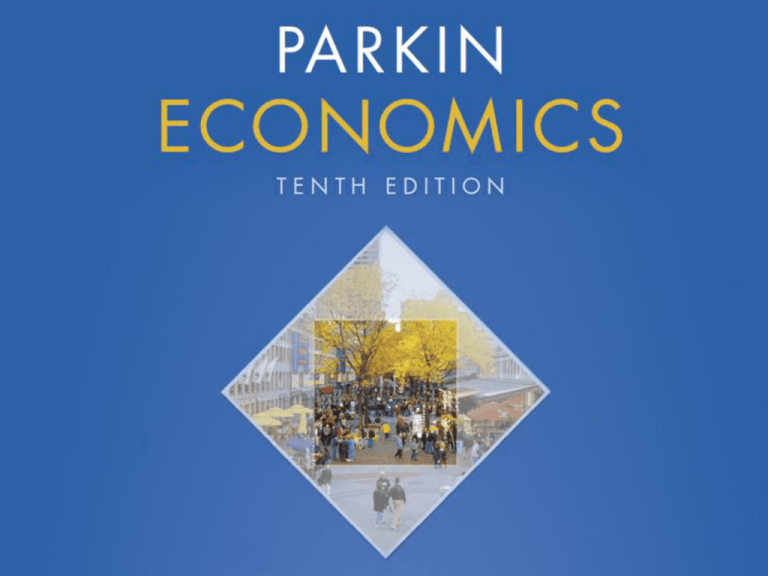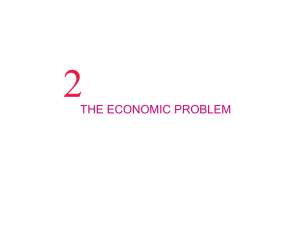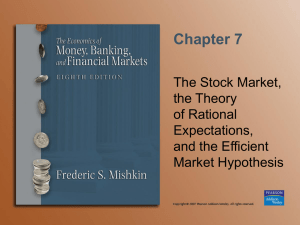
1
WHAT IS ECONOMICS?
Definition of Economics
All economic questions arise because we want more than
we can get.
Our inability to satisfy all our wants is called scarcity.
Because we face scarcity, we must make choices.
The choices we make depend on the incentives we face.
An incentive is a reward that encourages an action or a
penalty that discourages an action.
© 2012 Pearson Addison-Wesley
Definition of Economics
Economics is the social science that studies the choices
that individuals, businesses, governments, and entire
societies make as they cope with scarcity and the
incentives that influence and reconcile those choices.
Economics divides in to main parts:
Microeconomics
Macroeconomics
© 2012 Pearson Addison-Wesley
Definition of Economics
Microeconomics is the study of choices that individuals
and businesses make, the way those choices interact in
markets, and the influence of governments.
An example of a microeconomic question is: Why are
people buying more e-books and fewer hard copy books?
Macroeconomics is the study of the performance of the
national and global economies.
An example of a macroeconomic question is: Why is the
unemployment rate in the United States so high?
© 2012 Pearson Addison-Wesley
Two Big Economic Questions
Two big questions summarize the scope of economics:
How do choices end up determining what, how, and for
whom goods and services get produced?
When do choices made in the pursuit of self-interest
also promote the social interest?
© 2012 Pearson Addison-Wesley
Two Big Economic Questions
What, How, and For Whom?
Goods and services are the objects that people value
and produce to satisfy human wants.
What?
Agriculture accounts for less than 1 percent of total U.S.
production, manufactured goods for 22 percent, and
services for 77 percent.
In China, agriculture accounts for 11 percent of total
production, manufactured goods for 49 percent, and
services for 40 percent.
© 2012 Pearson Addison-Wesley
Two Big Economic Questions
Figure 1.1 shows these
numbers for the United
States and China.
It also shows the
numbers for Brazil.
What determines these
patterns of production?
How do choices end up
determining the quantity
of each item produced in
the United States and
around the world?
© 2012 Pearson Addison-Wesley
Two Big Economic Questions
How?
Goods and services are produced by using productive
resources that economists call factors of production.
Factors of production are grouped into four categories:
Land
Labor
Capital
Entrepreneurship
© 2012 Pearson Addison-Wesley
Two Big Economic Questions
The “gifts of nature” that we use to produce goods and
services are land.
The work time and work effort that people devote to
producing goods and services is labor.
The quality of labor depends on human capital, which is
the knowledge and skill that people obtain from education,
on-the-job training, and work experience.
The tools, instruments, machines, buildings, and other
constructions that businesses use to produce goods and
services are capital.
The human resource that organizes land, labor, and
capital is entrepreneurship.
© 2012 Pearson Addison-Wesley
Two Big Economic Questions
Figure 1.2 shows a
measure of the growth of
human capital in the
United States over the last
century—the percentage
of the population that has
completed different levels
of education.
Economics explains these
trends.
© 2012 Pearson Addison-Wesley
Two Big Economic Questions
For Whom?
Who gets the goods and services depends on the incomes
that people earn.
Land earns rent.
Labor earns wages.
Capital earns interest.
Entrepreneurship earns profit.
© 2012 Pearson Addison-Wesley
Two Big Economic Questions
Can the Pursuit of Self-Interest Promote the Social
Interest?
Every day, 311 million Americans and 6.9 billion people in
other countries make economic choices that result in
What, How, and For Whom goods and services are
produced.
Do we produce the right things in the right quantities?
Do we use our factors of production in the best way?
Do the goods and services go to those who benefit most
from them?
© 2012 Pearson Addison-Wesley
Two Big Economic Questions
Self-Interest
You make choices that are in your self-interest—choices
that you think are best for you.
Social Interest
Choices that are best for society as a whole are said to be
in the social interest.
© 2012 Pearson Addison-Wesley
Two Big Economic Questions
The Big Question
Can choices made in self-interest promote the social
interest?
© 2012 Pearson Addison-Wesley
Two Big Economic Questions
Four topics that generate discussion and that illustrate
tension between self-interest and social interest are
Globalization
Is globalization in the social interest?
© 2012 Pearson Addison-Wesley
The Economic Way of Thinking
Six key ideas define the economic way of thinking:
A choice is a tradeoff.
People make rational choices by comparing benefits
and costs.
Benefit is what you gain from something.
Cost is what you must give up to get something.
Most choices are “how-much” choices made at the
margin.
Choices respond to incentives.
© 2012 Pearson Addison-Wesley
The Economic Way of Thinking
A Choice Is a Tradeoff
You can think about every choice as a tradeoff—an
exchange—giving up one thing to get something else.
On Saturday night, will you study or have fun?
You can’t study or have fun at the same time, so you must
make a choice.
Whatever you choose, you could have chosen something
else. Your choice is a tradeoff.
© 2012 Pearson Addison-Wesley
The Economic Way of Thinking
Making a Rational Choice
A rational choice is one that compares costs and
benefits and achieves the greatest benefit over cost for the
person making the choice.
Only the wants of the person making a choice are relevant
to determine its rationality.
The idea of rational choice provides an answer to the first
question: What goods and services will be produced and
in what quantities?
The answer is: Those that people rationally choose to buy!
© 2012 Pearson Addison-Wesley
The Economic Way of Thinking
How do people choose rationally?
The answers turn on benefits and costs.
Benefit: What you Gain
The benefit of something is the gain or pleasure that it
brings and is determined by preferences
Preferences are what a person likes and dislikes.
© 2012 Pearson Addison-Wesley
The Economic Way of Thinking
Cost: What you Must Give Up
The opportunity cost of something is the highest-valued
alternative that must be given up to get it.
What is your opportunity cost of going to an AC/DC
concert?
Opportunity cost has two components:
1. The things you can’t afford to buy if you purchase the
AC/DC ticket.
2. The things you can’t do with your time if you spend at
the concert.
© 2012 Pearson Addison-Wesley
The Economic Way of Thinking
How Much? Choosing at the Margin
You can allocate the next hour between studying and
instant messaging your friends.
The choice is not all or nothing, but you must decide how
many minutes to allocate to each activity.
To make this decision, you compare the benefit of a little bit
more study time with its cost—you make your choice at the
margin.
© 2012 Pearson Addison-Wesley
The Economic Way of Thinking
To make a choice at the margin, you evaluate the
consequences of making incremental changes in the use
of your time.
The benefit from pursuing an incremental increase in an
activity is its marginal benefit.
The opportunity cost of pursuing an incremental increase
in an activity is its marginal cost.
If the marginal benefit from an incremental increase in an
activity exceeds its marginal cost, your rational choice is to
do more of that activity.
© 2012 Pearson Addison-Wesley
The Economic Way of Thinking
Choices Respond to Incentives
A change in marginal cost or a change in marginal benefit
changes the incentives that we face and leads us to
change our choice.
The central idea of economics is that we can predict how
choices will change by looking at changes in incentives.
© 2012 Pearson Addison-Wesley
Economics: A Social Science and
Policy Tool
Economist as Social Scientist
Economists distinguish between two types of statement:
What is—positive statements
What ought to be—normative statements
A positive statement can be tested by checking it against
facts.
A normative statement expresses an opinion and cannot
be tested.
© 2012 Pearson Addison-Wesley







